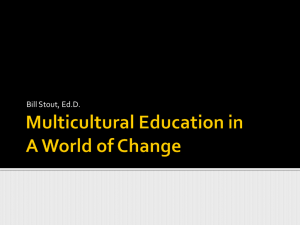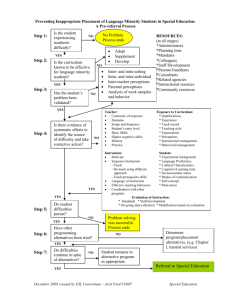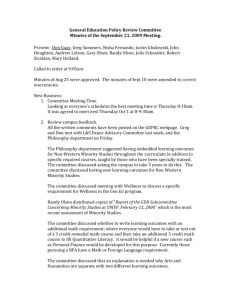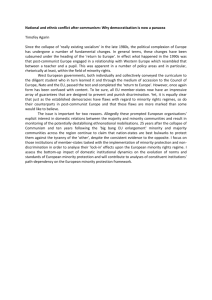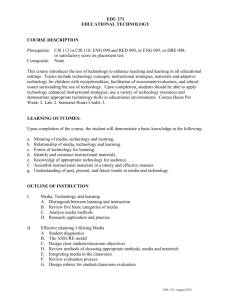chapter03
advertisement
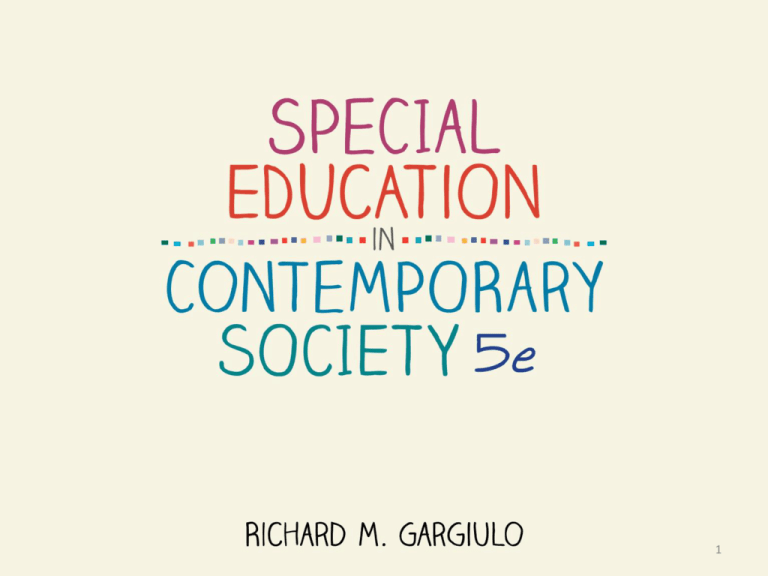
1 Chapter Three Cultural and Linguistic Diversity and Exceptionality 2 Terminology of Cultural Differences – Culture • The attitudes, values, belief systems, norms, and traditions shared by a particular group of people that can be reflected in their language, religion, dress, diet, and social customs. – Multiculturalism • Acknowledgement and acceptance of many different cultures that have equal value. Individuals can function in more than one culture. – Multicultural education • Education that is infused throughout the curriculum and values the customs, race, language, and ideas of all cultures including cultural constructs such as race, gender, and disability. 3 _Bilingual education • An educational strategy for students whose first language is not English where they receive instruction in their native language while learning English. – Macroculture • Core national culture which represents a shared culture such as American individualism and independence. – Microculture • Distinct subcultures within the larger culture that retain their own unique characteristics. – English Learners • Individuals whose primary or home language 4 Terminology of Cultural Differences • Describing diversity – The federal government only recognizes seven distinct racial groups: American Indian or Alaskan Native, Asian, Black, Hispanic, Native Hawaiian or Other Pacific Islander, White Two or More Races 5 6 7 Disproportional Representation • Minority students are disproportionally represented in special education • Overrepresentation: a situation in which greater numbers of students of certain groups are placed in special education than you would expect based on their numbers in the school population • Underrepresentation: fewer students in a particular category than one might expect based on their numbers in the school population 8 Disproportional Representation • There is typically an overrepresentation of minority students in special education programs. • There is typically an underrepresentation of minority students in gifted and talented programs. 9 a. Over-representation of minority students receiving special education services/Under-representation of minority students in gifted and talented programs i. Relationship between family socioeconomic status (poverty) Minorities groups often live in urban areas that are associated with poverty and may have poor nutrition, adverse living conditions, and limited access to prenatal and healthcare. 10 Numerous reports have shown the negative influence of Factors Contributing to Over- and Underrepresentation • Relationship between family socioeconomic status (poverty) • Identification procedures by professionals from culturally dominant backgrounds • Instructional methodologies reflect dominant culture • Dominant culture teachers’ perceptions of diverse students’ learning needs 11 • Identification procedures – Faulty identification procedures, ineffective prereferral strategies, test bias, and inappropriate assessment techniques may also account for some of the overrepresentation. • Instructional methodology • Research demonstrates that children from minority groups may learn differently than White youngsters and teachers may not employ strategies that meet the learning styles of all of their students 12 – Consequences of a disproportionate representation of minority students in special education programs • May result in an inferior and less effective educational experience – Students who are removed from the general education classroom and curriculum may experience inferior educational opportunities due to limited expectations, supplies, instructional materials, and resources. • Increases risk for underachievement and school dropout – Minority students historically have higher rates of school dropout than their White classmates. • May create limited employment opportunities – Adults who did not complete high school are more likely to be unemployed or incarcerated. 13 14 Assessment and Disproportionate Representation • Inappropriate assessment tools and evaluation procedures lead to disproportionate representation – Over reliance on IQ tests – Different cultural and experiential backgrounds • Accurate assessment of culturally and linguistically diverse students with disabilities is essential for identification and program development 15 16 Assessment Innovations Nondiscriminatory assessments • Test revisions • Multiple intelligences instead of just IQ • Portfolio assessments • 17 Classroom Suggestions for Teachers of Culturally and Linguistically Diverse Students with Disabilities – Assess a child in both English and in the native language before administering other tests so that a child’s abilities in the native language can be determined. A student may have an English language barrier but understand the content in the native language. – A student must exhibit a disability when evaluated in the native language or the student does not have a disability. • Schools should use multiple assessment tools and procedures including a combination of formal and informal measures that are collected from the child, teacher(s), and the parents 18 Classroom Assessment Suggestions • Assess a child in both English and in the native language before administering other tests • A student must exhibit a disability when evaluated in the native language • Schools should use multiple assessment tools • Evaluators should use unbiased tools and techniques • An interpreter may be used if bilingual education is not available • Parents should be involved in developing assessments 19 Educational Suggestions Display sensitivity to the cultural heritage of all students • Use instructional strategies and materials that respect different learning styles and personal experiences • Consider the instructional environment and the impact on student behavior • 20 21



